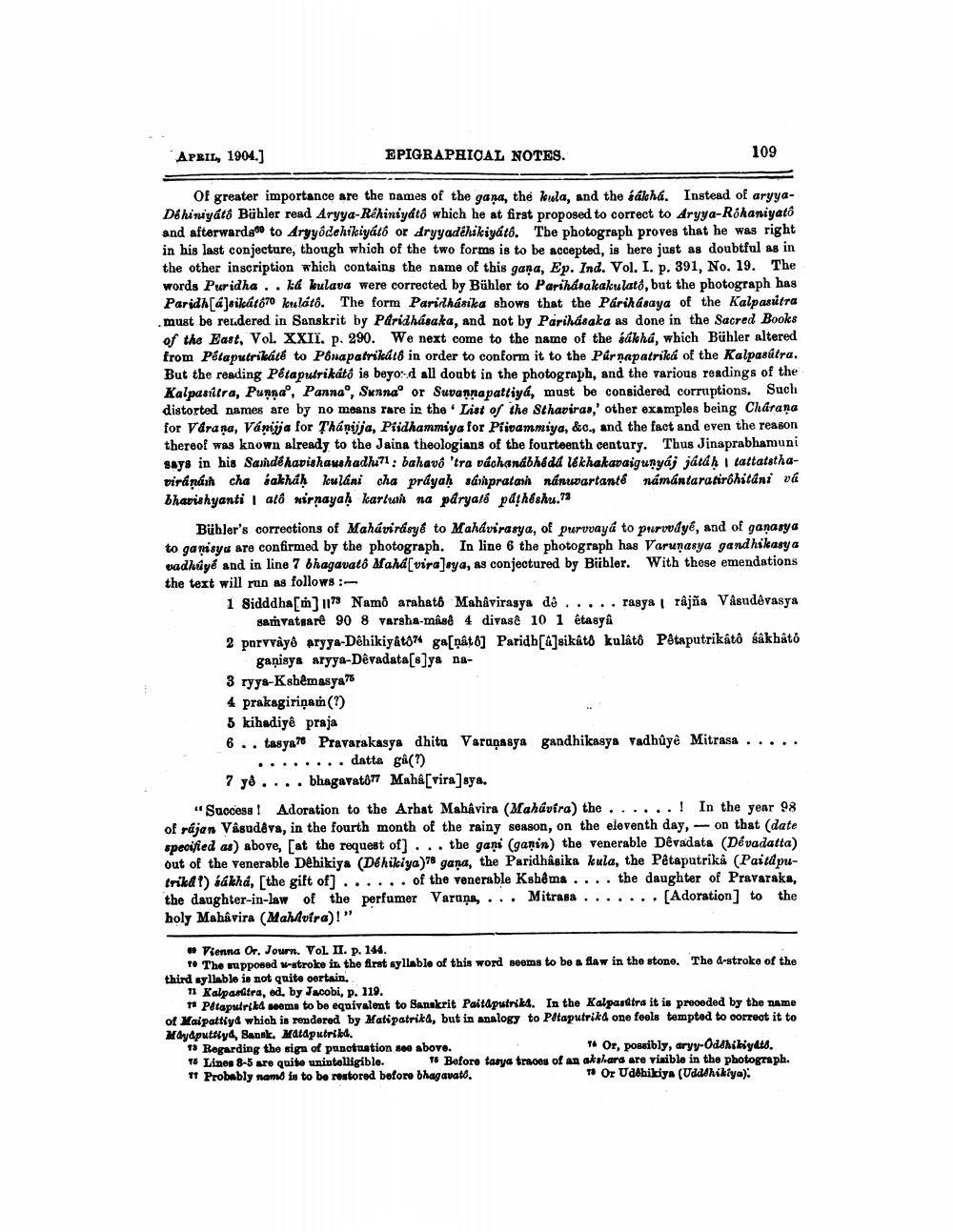________________
APRIL, 1904.]
EPIGRAPHICAL NOTES.
109
Of greater importance are the names of the gana, the Kula, and the sálcha. Instead of aryyaDé hiniyátó Bühler read Aryya-Rêhiniyátó which he at first proposed to correct to Aryya-Rókaniyatô and afterwards to Aryyódehikiyátó or dryyadékikiyátô. The photograph proves that he was right in his last conjecture, though which of the two forms is to be accepted, is here just as doubtful as in the other inscription which contains the name of this gana, Ep. Ind. Vol. I. p. 391, No. 19. The words Puridha .. ka kulava were corrected by Bühler to Parihásakakulats, but the photograph has Paridh[@]sikát670 kou látô. The form Parilhásika shows that the Parihasaya of the Kalpasitra must be rendered in Sanskrit by Paridhásaka, and not by Parihásaka as done in the Sacred Books of the East, Vol. XXII. p. 290. We next come to the name of the kák há, which Bühler altered from Pétaputrikáté to Ponapatrikd18 in order to conform it to the Pár napatriká of the Kalpasútra. But the reading Pétaputrikátó is beyo-d all doubt in the photograph, and the various readings of the Kalpasitra, Punnao, Panna, Sunna or Suvannapattiya, must be considered corruptions. Such distorted names are by no means rare in the List of the Sthaviras,' other examples being Charana for Varana, Várjja for Thánijja, Piidhammiya for Piivammiya, &c., and the fact and even the reason thereof was known already to the Jaina theologians of the fourteenth century. Thus Jinaprabhamuni says in his Sandé hapishawahadhu71 : bahavo 'tra váchanábheda lekhakapaigunyáj játák | tattatsthaviránáin cha bakháh kulani cha práyah sampratani nánuartante námántaratir hitáni vá bhavishyanti | ato nirnayah kartun na páryalé pdfh&shu.73
Bühler's corrections of Mahávirásyć to Mahávirasya, of puruvayá to purvodye, and of ganasya to ganisya are confirmed by the photograph. In line 6 the photograph has Varunasya gandhikasya vadhúyé and in line 7 bhagavató Maha(viraloya, as conjectured by Biibler. With these emendations the text will run as follows:
1 Sidddha(í) 1173 Namo araható Mahavirasya de ..... ragya rajña Vasudevasya
samvatsarê 90 8 varsha mase 4 divasa 10 1 étasya 2 parvvâyð aryya-Dêhikiyat8% ga[ņât8] Paridh[a]sikâtó kulâtó Pétaputrikátó såkháto
gaņisya aryya-Devadata[s]ya na3 ryya-Ksbêmasya 76 4 prakagiriņam (1) 5 kihadiyê praja 6 .. tasya76 Pravarakasya dhita Varaṇasya gandhikasys vadhûyê Mitrasa ....
........ datta gå(1) 7 yê . . . . bhagavatő77 Mahâ[vira]sya. "Success! Adoration to the Arhat Mahavira (Mahavira) the ......! In the year 98 of rájan Vâsudava, in the fourth month of the rainy season, on the eleventh day, on that (date specified as) above, [at the request of) ... the gani (ganin) the venerable Dêvadata (Dévadatta) out of the venerable Dehikiya (D& hikiya)78 gana, the Paridhisika kula, the Pétaputrika (Paitdputrik& t) áá khá, [the gift of] ...... of the venerable Kshêma .... the daughter of Pravaraka, the daughter-in-law of the perfumer Varuna,... Mitrasa ....... (Adoration] to the holy Mahâvira (Mahlvira)!”
# Vienna Or, Journ. VOL II. p. 144.
T The mupposed w-stroke in the first syllable of this word seems to be a flaw in the stone. The 4-stroke of the third ayllable is not quite certain.
11 Kalpardtra, ed. by Jacobi, p. 119.
* Pataputrid sooms to be equivalent to Sanskrit Paitaputrikt. In the Kalpastra it is preceded by the name of Kaipattiyd which is rendered by Matipatrika, but in analogy to Petaputrikd one feels tempted to correct it to Mdydputtiyd, Sansk. Matdputribd. 18 Regarding the sign of punctuation se above.
* Or, possibly, aryy-Oddhikiydts. T5 Lines 8-5 are quite unintelligible.
Before tarya traces of an akshara are visible in the photograph. T1 Probably namo is to be restored before bhagavató.
To Or Uddhiliya (Udddhikiya)




